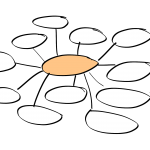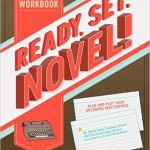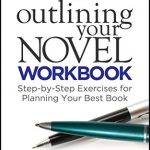B is for Blank Page
This is where all published novels begin life, and this post is about the different approaches an author might take to writing.
If you are preparing to write your first novel, I would hope (and advise) that you start your novel writing career with some short stories. It is far easier to learn the elements of creative writing in a short 1,000-word story than a novel-length work of 50,000 words plus. The principals are the same:
- You need a beginning, middle, and end.
- Rising action (conflict) leading to a dramatic ending (climax)
- Three-dimensional characters and realistic dialogue
- A good balance of narrative and exposition
- An engaging plot and narrative voice
(There is more to a story writing than this, of coure, I’ve just touched on the basics).
So, the blank page…
If you’re anything like me, you’ll have an idea bouncing around your head, demanding to be put on paper (or screen). You might have the entire work mapped out in your head – characters, setting, and final conflict included – or just the inkling of an idea.
I always start with the latter. A scenario pops into my mind, potential candidates and a setting, and without much more thought I open a blank page and write. I am what is known as a Pantser, (which is the opposite of a Planner).
There is no ‘correct’ method of writing (so don’t let anyone tell you otherwise). If you need to research every trait your character has, every setting, plot point, and twist, then you go ahead and do that. Likewise, if you’re like me and begin your novel with the vaguest of ideas – just write — and see where it takes you.
The ‘Planner’
The planner (and forgive me for generalising here) will want to know everything about their story before settling down to write. They may have created full bios for each of their characters, including backstory and how they will interact with others. They will certainly have a detailed plot outline and know what will happen in each chapter. I won’t be so bold as to say a planner won’t experience a few surprises while writing, but my understanding of planning is that every plot point is mapped out and prepared for in advance. Incidentally, my one foray into planning a book failed – my characters took over in chapter two and after a brief battle of wills, steered my story into a direction I hadn’t planned for.
One of the pros to planning is that you know in advance what will happen, who it will happen to, and how it will end. If planned correctly, there will be fewer chances for plot holes to make an appearance, or inconsistencies (as you’ll have notes to remind you what car Bob drives, or what hair colour Doris has).
The ‘Pantser’
This is pretty much how I described it above. An idea pops to mind, you open to a blank page and write. I usually have a scenario in mind, and a character or two. Usually, I have a vague idea of an ending, but that is all I begin with. As I write, I get to know my characters and learn about the world I’ve placed them in, and they’re always surprising me. I create twists and make connections as I go, yet if I try to plan all this out, my brain ceases to think beyond the basics.
One drawback to pantsing (with me anyway), is that I change my mind a lot, but by the end of my (truly terrible) first draft, having spent most of my time running behind my characters and taking notes on all their shenanigans, I know exactly what my story is about and who my characters are. I suppose you could say that my first draft is my outline. Once I’ve cut the rubbish out, I will sit and outline it (loosely), before beginning my second draft.
Methods of encouraging creativity
The first page (in my experience) is the hardest to write. Every November I participate in Nanowrimo (National Novel Writing Month), and when I look at that blank page in my brand new document, regardless of how enthusiastic the ideas in my head are, I sit there and wonder ‘how on earth I get started.’
The answer?
Any way you want (because you’ll end up editing that first page – and chapter/book — multiple times before you publish, trust me on that).
Freewriting
Freewriting is the technique whereby you (speed) write for a set period of time – about anything of your choosing – with the intention of letting your mind go where it will. I often use this method if my writing stalls (writer’s block) or to explore a particular character or theme. Basically, you just write. You can choose a prompt if you wish but keep your pen moving and don’t try and control your thoughts. The purpose of freewriting is to tap into your stream of consciousness. The results can be rather surprising.
Mind maps
 An alternative to freewriting is a mind map, which can work on the same principle, but it’s more visual.
An alternative to freewriting is a mind map, which can work on the same principle, but it’s more visual.
You enter a keyword or prompt in the centre of a blank page, then think of all the things that might connect to it.
Prompts
There are many sites online offering story prompts. One of my favourite places to go to is Pinterest (keyword: writing prompt).
Images
While on the subject of Pinterest, you might want to consider typing in a keyword for a story you would like to write about and using an image as your ‘prompt’.
Story generators
As with prompts, there are several of these around on the world wide web, and these days, there are even some apps. One of my favourite websites, however, (owing to the fact I like SFF), has to be Seventh Sanctum. I’ve spent many a time playing with their story, weapon, and technology generators. I don’t always use them, but they inspire me.
And finally…
I’m going to end this (rather long) blog post with some links to books and software I have personally found to be of use over the years. I only promote books (on this website anyway) that I have used or read and that I’m happy to vouch for.
Software:
Ywriter – free software (and my favourite). You can read more about how I use this here.
Scrivener (I haven’t yet got around to learning Scrivener, but it has a lot of wonderful features for planners)
Books:




That blank page sure is intimidating, you’re right. I’m half and half. I outline specific beats in my story then let the characters take over from there. It seems to work better for me than just doing one or the other.
Doree Weller
Really informative post Michelle. I like to be a pantser but i’m gradually learning how to be a planner. i think there is a lot of scope for somewhere in the middle where i kind of have an idea of where i want to go but let the characters tell their own story with those parameters in mind. I find it amazing how they come to life.
I’ve also recently purchased Scrivenor and it is a mind blowing tool for any writer. I can’t say that i have learnt how to use half of its capability, but what i do use has certainly helped with the planning and the flow of the work.
I’d also recommend Literature and Latte’s other writing programme called ‘scapple’ for those people who like to mind map. It is absolutely brilliant.
They also have a thirty day free trial on both of these products. (and no, i’m not affiliated in any way).